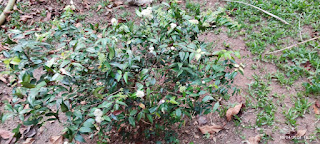My salutations are to some very rare individuals who took it upon themselves as a mission to conserve the local biodiversity. In Kochi, two such people come to my mind.
One was Meena Menon who had fought a losing battle against KSEB and government machinery to preserve some 10 acres of forest patch on the National Highway close to Paravur in Ernakulam, which could have easily fetched her millions, but who chose to keep the ancestral property as a green patch for the posterity! She is no more! May she enjoy evergreen peace!(https://prasantamcmi.blogspot.com/2022/10/meena-menon-solo-local-green-warrior.html)
The other is Sri Ramachandran who retired from Forest Service and also served as a member of the biodiversity board. Under his leadership, the Ponnekkad family had dedicated some 10 acres of land which was part of their traditional sacred grove intact, so that it remains a biodiversity spot for posterity! My salutations to both. Both have become study centres for life science students and nature enthusiasts.
My own efforts at Rajagiri campus to enrich its biodiversity was not resisted by anyone, except that as and when it was felt that a concrete structure had to be raised, the green structure was razed without any compunction or thought for that.
The grand Rajagiri College building of some 7 floors built around 2013 in a plot of about 40 cents was once a dumping area, where rubble of all sorts of construction on the campus used to be dumped. Then it occurred to us that this could be utilised for further expansion of the college and a 7-storey building was envisioned, and some rudimentary plan was made with provisions for a swimming pool in one of the floors. Our civil engineer confrere Fr Joy was called in for initial consultation and a rough scheme emerged. Then our dynamic senior faculty Dr Injodey suggested why not we utilise our Kakkanad property for having our Management Studies departments there, and let the Kalamassery campus retain its old time charm of social work and social action. This was endorsed by the open-to-all-new-ideas person, Rev Fr Alex, and thus the school of management had its birth in Kakkanad.
 In the meanwhile, the 40 cents plot was used for dumping the litter of the campus which in due course got converted into very soft mulch. And we started a campaign to increase biodiversity and various indigenous species were added to the plot, and what remained of a discarded project of a herbal garden (typical of externally funded project-based initiatives - funding over, project over), we protected (I recall, Asafoetida, Malaysian Tamarind also called jungle jalebee, chaturamulla, kallipala - all of which not commonly found), and in a matter of 6 or 7 years, the 40 cents had almost a 100 species there. I had brought local species like punna, forest species like tambakam, other species like mulberry, gooseberry, some sort of cherry, atalotakam, ... , manja mandaram, some very special varieties of rose apple... It was a thrill to have them. However, when the next phase of college development took place, the dedicated spot was taken over by a grand structure, and all those precious collections were removed without any thought of replacement.
In the meanwhile, the 40 cents plot was used for dumping the litter of the campus which in due course got converted into very soft mulch. And we started a campaign to increase biodiversity and various indigenous species were added to the plot, and what remained of a discarded project of a herbal garden (typical of externally funded project-based initiatives - funding over, project over), we protected (I recall, Asafoetida, Malaysian Tamarind also called jungle jalebee, chaturamulla, kallipala - all of which not commonly found), and in a matter of 6 or 7 years, the 40 cents had almost a 100 species there. I had brought local species like punna, forest species like tambakam, other species like mulberry, gooseberry, some sort of cherry, atalotakam, ... , manja mandaram, some very special varieties of rose apple... It was a thrill to have them. However, when the next phase of college development took place, the dedicated spot was taken over by a grand structure, and all those precious collections were removed without any thought of replacement.
Perhaps, in the whole city of Kochi, we were the only ones who could have boasted of having a Jacrinda tree. Usually, it is not found in this region, perhaps, it is exotic. However, it blooms in violet all over in hilly areas of Munnar. In 1997, an administrator felt that this was wasting space and was a kind of barrier to smooth traffic on the campus. It was cut off with no consultation whatsoever. Dr Injodey the Botanist felt aggrieved, and I shared the same sentiment. I tended to the stump, and it sprouted again, and we managed to get a sturdy tree out of it, which bloomed very rarely. Last year (2023) I saw it in bloom - nothing comparable to the Munnar blooms. However, when I visited the campus next towards the end of the year, the tree was removed and was replaced with some ornamental plants!!
 While I felt sad that the huge Jamun tree with abundant fruits was brought down, I was glad to see that 2 or 3 of them, as well as a jack tree, planted under our initiative, were bearing fruit. Some new, exotic, however, most likely of no negative impact kind of species, especially fruit trees have been introduced, replacing the monoculture of rubber plantation on the campus.
While I felt sad that the huge Jamun tree with abundant fruits was brought down, I was glad to see that 2 or 3 of them, as well as a jack tree, planted under our initiative, were bearing fruit. Some new, exotic, however, most likely of no negative impact kind of species, especially fruit trees have been introduced, replacing the monoculture of rubber plantation on the campus.
No comments:
Post a Comment